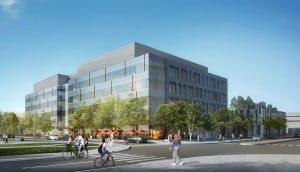
The Davis Cos. is developing a 223,000-square-foot lab building at 35 Cambridgepark Drive scheduled for completion in mid-2018.
Cambridge, one of the top three life sciences markets nationally, is considered the epicenter due to numerous factors. The most significant is proximity and access to area universities and research institutions, such as MIT, Harvard, the Broad Institute and the Whitehead Institute.
There has been intense growth of life sciences companies in Cambridge from a variety of channels. Many existing tenants have expanded, countless new ventures have rolled out of incubation mode, and several established companies with household names have established a presence in Cambridge to be part of this bustling life science community.
As other prominent domestic life sciences markets including New York City, San Diego, San Francisco and North Carolina’s Research Triangle experience more growth and mature, they will create their own similar ecosystems. For now, Cambridge’s delineation as the top tier has a major impact on rents and types of construction projects in the area.
While leasing velocity for office space is slowing down in Cambridge as a result of increased rents and an ongoing trend of tenants migrating to Boston, the demand for lab space has remained high. Rents for lab space in Cambridge have risen considerably, eclipsing $80-per-square-foot triple-net in some cases or over $100 per square foot when factoring in taxes and operating expenses. One reason for the steady rise in Cambridge rents is that it has proven critical to many tenants in the market to remain there despite the cost. Some Cambridge-born life sciences companies have moved out, most going to Brighton, Watertown, Lexington or Waltham, maintaining some proximity to ground zero. One group going the other way is one of the state’s largest life sciences firms, Shire Pharmaceuticals. Despite the massive cost differential and its established presence and infrastructure in Lexington, Shire is making a strong push to relocate much of its footprint into Kendall Square.
Handful Of Landlords Dominate Market
As more life sciences companies have spread their wings and left the Cambridge nest, several suburban life sciences clusters have been created, making it easier for others to consider a move. Savvy and opportunistic landlords have repositioned and/or developed buildings that either cater specifically to life sciences tenants or at least provide enough clear height and infrastructure to support them. The new LINX project in Watertown is open for business for both office and lab users. Because they can easily support lab use and are located a short bus ride from Harvard Square, much of the activity there is from life sciences companies coming out of Cambridge. Another new life science development, Alewife Research Center at 35 Cambridgepark Drive, is under construction and expected to deliver in the third quarter of 2018. We expect this project to see a good amount of activity from East Cambridge tenants that have limited options.
There has been significant consolidation of life sciences properties in the Greater Boston market. In Cambridge specifically, only four landlords control more than 80 percent of the life science market. As a tenant, this presents certain challenges and can be limiting when attempting to build leverage. However, a landlord with a large portfolio of life sciences space can also be an asset. The major landlords are typically willing to provide more funds for capital improvements than office space-focused landlords, and it’s nice to have a landlord with the ability to help expand or contract within the portfolio as tenant needs change well before their lease expires.
Limited Availability In The Sweet Spot
In the Cambridge market, a 5,000- to 20,000-square-foot lab space is the hot size for startups, with limited availability. In fact, some life science-focused VC companies such as Third Rock Ventures, Atlas Ventures and Flagship are taking historically larger blocks so if one portfolio company does not succeed, they can backfill the remaining space with another of their companies as needed. In the suburbs, the typical lab space requirement tends to range at a larger 20,000 to 40,000 square feet. By the time a company grows and expands into the suburbs, the company is more mature and has a better grasp on its employee profile so can acquire a bigger space, and justify its suburban location both economically, and culturally.
Cambridge’s life sciences cluster, with access to both specialized sites and a skilled workforce, appears set to experience a continued growth and expansion for leasable life science space well into the future.
John Coakley and Paul Delaney are senior vice presidents at Cresa Boston, a part of the world’s largest tenant-only commercial real estate firm. For more information, visit www.cresa.com/boston.




 |
| 

